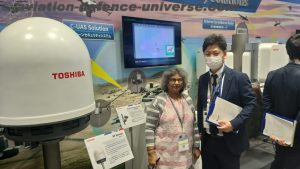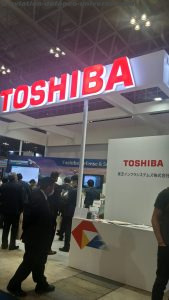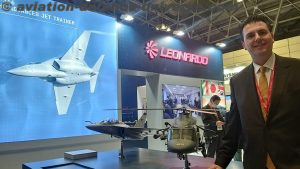By Sangeeta Saxena
Chiba, Japan. 18 March 2023. In the changed war zones of modern day warfare, unmanned systems are the biggest threat , most difficult to identify and track, thereby most responsible for damages if they evade the radars. From big drones to nano-UAVs the human eye can’t see at a distance, and regardless of the weather or time of day, no drone is able to elude Toshiba’s radar, claims the Japanese defence major. “Drones approach when you least expect them. With our long range radar, you can grasp the target’s flight state in advance and take action instantly to prevent disaster,” the spokesman at the Toshiba stand confidently declares. And why not? His products are attracting the maximum eyeballs. It is motivating to note that not even the impending buyout offer of Toshiba has deterred the company from showcasing it’s combatant systems at DSEI Japan 2023 in Chiba. The Counter-UAS has an impressive product lineup. The components for multi-mission C-UAS solution detect, track, analyse and mitigate suspicious drones.
 The RF sensor covers the entire perimeter with a single unit. It analyzes the waveforms of multiple radio waves simultaneously and checks them against a database to detect signals emitted by drones. Since the RF sensor does not emit radio waves, there is no risk of causing radio interference, no radio licenses or special procedures are required to operate it. One RF sensor can detect radio waves emitted by drones in a full 360-degree circle. Covering large areas with the minimum equipment configuration, it enables an operation even in an area or environment where it is not possible to install multiple units.
The RF sensor covers the entire perimeter with a single unit. It analyzes the waveforms of multiple radio waves simultaneously and checks them against a database to detect signals emitted by drones. Since the RF sensor does not emit radio waves, there is no risk of causing radio interference, no radio licenses or special procedures are required to operate it. One RF sensor can detect radio waves emitted by drones in a full 360-degree circle. Covering large areas with the minimum equipment configuration, it enables an operation even in an area or environment where it is not possible to install multiple units.
It has long, medium and small range radars. From the radar’s location to the inbound drone’s, the radar measures the range, directions and altitude of the target. It creates the flight database of the target and improves the analysis of the object. Short and Middle Range Radar are low size, weight, and powered with an electronically scanned, phased array enabling 3D detection of targets. It is flexibly scalable and installable for venues, infrastructure, cities and regions. It is small, lightweight, easy to deploy and is mountable on platforms such as UAS. It has 3D Detection (Direction/Distance/Altitude) and can detect “dark drones” that don’t transmit any radio waves. It has automatic target identification by Artificial Intelligence and has threat analysis capability. From the radar’s location to the inbound drone’s, the large radar measures the range, directions and altitude of the target. It creates the flight database of the target and improves the analysis of the object.
For eliminating threats the autonomous hunting drone operates autonomously, capturing drones with its net guns, and physically tows the captured drone away to a safe location. It does tracking and capturing targets automatically for physical mitigation of threats. It reduces risk of collateral damage caused by hostile drones crashing. Captured drones can be studied for forensic analysis. This event is a unique platform for the entire security industry to come together to source products, share experiences and gain the knowledge needed to address current and emerging security challenges.
TISS has taken this opportunity to showcase its C-UAS Solution, a comprehensive solution for countering the emerging threats of drones at DSEI Japan 2023 for a global audience.
































































































































